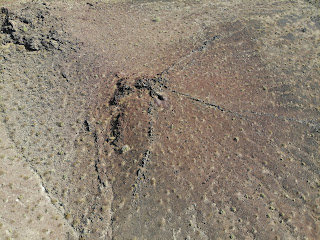There have been numerous M4-M5 earthquakes in the Awash area of Ethiopia over the last few months. This is within the Main Ethiopia Rift at its NE end where it begins to open into the Afar. There is a young volcano Fentale in that area which had an eruption last in 1820.
Nice post fromn the Euro-Mediterranean Seismological Centre (EMSC): SUMMARY
Here is a live link of that area: LINK--last 24 hours
Here is the same area: LINK--7 days
That would also mean that there have been many smaller events (Gutenberg-Richter law suggests 10x for each integer decrease in magnitude). The global seismic networks the USGS uses have an M4 cutoff outside the US. These are shallow events (10km default depth). I would bet they are even shallower but that is all the network location can provide.
No doubt the Main Ethiopian Rift is active and extending NW-SE a few mm/yr (hence the NE-SW trending faults in the area). So, we should not be surprised to see the events. The focal mechanisms (directionality of first motions) are consistent with motion along those faults.
The location accuracy is probably only good to 5-10 km so these events might actually be more well aligned with themselves and faults in the area instead of the cloud in the map above.
What is intriguing to me is that it is a swarm. I would not be surprised if there were also some interaction with the magmatic system of the Fentale to Mt. Dofan. I note the InSAR data in this LINK that seems consistent with intrusions along the rift NE of Fantale. Here is footage of an eruption on January 3, 2025 in the area NE of Fantale (Mt. Dofan) where the more recent events have occured: LINK. Thanks to Amy Rector for the link.
It is interesting and certainly in the near field, these events could damage unreinforced masonry structures as well as frighten people and animals. These events have been felt in Addis Ababa (~200 km distance) as moderate to weak shaking.
Links:- Earthquake Insights post
- Volcano Cafe blog entry: LINK
- Mud volcano and phreatic behavior: LINK
- VOA article: LINK
- Newspaper report after recent larger earthquakes: LINK
- Newspaper report with some nice field pictures with fracturing: LINK
- Useful local commentary (in Amharic): LINK
- I did find an interview with Prof Ataley Ayale who runs the seismic station at Addis Ababa University. He does not have a lot more to say: https://addisstandard.com/although-earthquakes-measuring-5-0-or-higher-are-relatively-uncommon-in-ethiopia-they-still-pose-a-significant-risk-to-infrastructure-and-human-safety-atalay-ayele-prof-a-geoph/
- Earthquake history of Ethiopia by Pierre Gouin
- Interferogram by Carolina Pagli team indicating intrusions likely: LINK




















